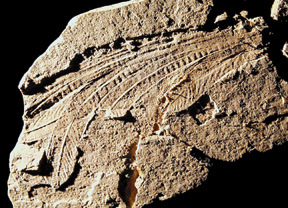geotimesheader
News
Notes
Birds vs.
bones
A spry contender has entered the ring this summer in the debate over
the origin of birds. Its body may only be a few centimeters long, but its
wings pack a big punch. The only problem is that its rival, a heavyweight
champion, hasn’t even put on its gloves.
Some experts are putting their money on a 220 million-year-old fossil,
whose stalky plumage may be the oldest feathers ever discovered. The fossil
provides a rallying point for a small group of iconoclasts who disagree
with the mainstream theory that birds evolved from theropod dinosaurs —
bipedal carnivores including the infamous velociraptors of Jurassic
Park. Scientists who believe birds are the descendents of theropod
dinosaurs are the odds-on favorite and demand a worthier opponent before
they’ll consider a match.
The fossil, Longisquama insignis, was part of a collection on
tour in the United States from the Russian Academy of Sciences’ Paleontological
Institute in Moscow and was originally found in central Asia. John A. Ruben
of Oregon State University led Terry Jones, his graduate student at the
time, and a team of Russian and American scientists in carefully describing
the tiny animal’s jetting appendages for a report in the June 23 issue
of Science. The authors and their theropod-bird linking adversaries
agree the animal is not a bird or a dinosaur but rather a reptile with
wings.

Measuring about 10 centimeters
long, these wings are the
feathered favorites of those
who reject the widely accepted
theory that dinosaurs led
to birds. |
But the authors argue “it has all the characteristics of feathers,”
says Jones, now of Stephen F. Austin State University in Nacogdoches, Texas.
And the unique characteristics of feathers, they say, were unlikely to
have evolved more than once.
Still, before they step out of the locker room, the heavyweight theropod
advocates are waiting for their opponents to answer one question: What
are the ancestors of birds if not theropods? For example, “if they said
that Longisquama is more closely related to birds than to all other
known creatures, than at least we could hypothesize that these elements
are the ancestral condition of feathers,” says vertebrate paleontologist
Thomas Holtz Jr. of the University of Maryland.
|
Others agree. “Methods, standards of evidence and testable hypothesis
are the business of science, and these guys aren’t with it,” says Kevin
Padian, professor of integrative biology and curator of the Museum of Paleontology
at the University of California, Berkeley. He compares the debate to the
early challenges of plate tectonics. “After a while, geologists accepted
that the continents move, even though some still disagreed, and the field
moved on. It’s way past time to do that with bird origins.” He’s been waiting
25 years for the ‘diehard’ opponents to point out a better ancestral link
to birds than theropods, he says.
Longisquama’s place in the family tree is still a mystery, but
it offers the first clue to what feathers may have looked like during the
Triassic. If indeed its structures are feathers, then its plumage predates
the feathers on the oldest definite bird, Archaeopteryx, by 75 million
years. Previous workers had named Longisquama after its “long scales”
but it has many of the modern features that define feathers, Ruben says.
Each structure is distinct with a midline shaft projecting fine, comb-like
barbs to either side. The bases of the shafts have a hollow quill similar
to that of modern
feathers and evidence of having developed within a follicle.
However, there are differences between modern feathers and the fossil
appendages of Longisquama. The gliding reptile is missing the Velcro-like
connections that prevent the fluffy ends of feathers from separating. Instead,
it has “a sort of ribbon connection that goes around the feather,” Jones
says. The wings also protrude from the creature’s spine rather than its
forearms. The authors consider the differences early steps on the evolutionary
path towards birds. “For a Triassic animal, it’s amazing we got as many
characteristics as we did,” says Larry Martin of the University of Kansas.
Vertebrate paleontologist Holtz calls the new interpretation of the
elongate structures “interesting,” but lacking the hypothesis needed for
a real challenge to the theory that birds evolved from theropods. It would
be better, he says, if the authors couched their hypothesis in an explicit
framework of patterns relating to common ancestry. Maybe then he and his
colleagues will be ready to enter the ring.
Christina Reed

